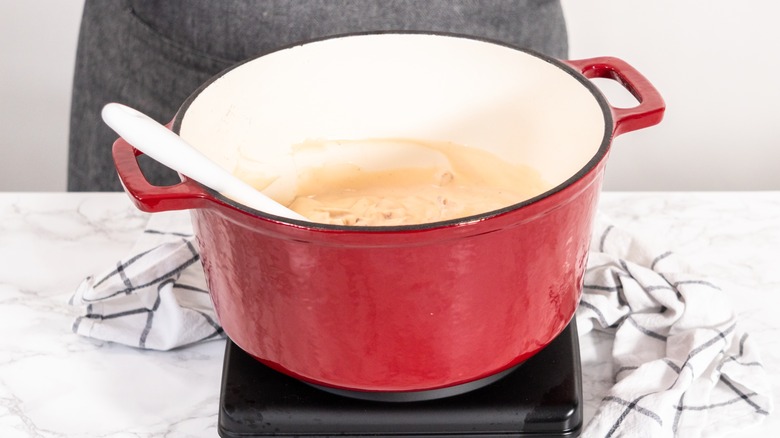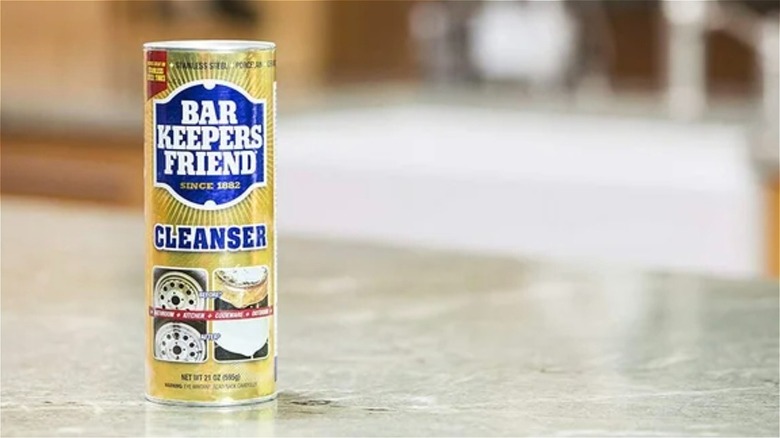Get Your Dutch Oven Sparkling Clean With This Trusty Product
We may receive a commission on purchases made from links.
Despite being around for hundreds of years, Dutch ovens remain the MVPs of the 21st-century kitchen. These powerhouses can be used for anything from roasting to braising to frying. Because the things you cook in them tend to involve lots of burnt-on, caked-on, greasy residue, thoughts of cleaning your Dutch oven may induce a migraine — but despair not. There's one common household cleaner that will get your enameled cast iron cookware squeaky clean in no time at all: Bar Keepers Friend.
Praised by the likes of celebrity chef Michael Symon on X, formerly known as Twitter, Bar Keepers Friend is easy to find online and inexpensive (under $12 for a pack of two on Amazon). It was invented in the late 1800s by a chemist who noticed his formerly-blackened pan was sparkling clean after he used it cook up some rhubarb. After investigating, he found that rhubarb — among other vegetables — contains oxalic acid, which induces a chemical reaction that breaks up rust and other tough stains. The chemist sold his new product to tavern owners who used it to keep their bar rails shiny and bright. It wasn't long before people realized it could be used to clean knives, pots and pans, and other metal objects as well.
How to use Bar Keepers Friend to clean your Dutch oven
You don't need to be a bar keeper to clean your Dutch oven with Bar Keepers Friend. Nor do you need any fancy equipment, although you should probably wear gloves to protect your hands. Use a non-scratch, gentle scrubber, ideally one made with soft nylon. Avoid scrubbers made with aluminum or steel wool, as these could scratch your surface, and powder Bar Keepers Friend is already slightly-abrasive.
Wet the pot, sprinkle it with the powder, and add enough water to form a paste on the areas that need to be cleaned. This could include both the inside and outside of your pot. You could also use the liquid form of Bar Keepers Friend (or both types) instead. Then get to scrubbing, but remember, keep it gentle. You're not stripping paint. Too much force and you could scratch the surface. If it's particularly stained, you'll need a little extra elbow grease, and you may have to rinse and re-apply a couple times. Whatever you do, don't let the paste sit on the surface for too long (as in, more than a minute), because that could damage it. When it's clean, rinse your pot thoroughly and make sure there's no residue left. Residue build-up can potentially damage your Dutch oven over time. Wipe it dry with a soft cloth and you're done.
What to watch out for when cleaning your Dutch oven with Bar Keepers Friend
Like a Dutch oven itself, Bar Keepers Friend is extremely versatile and has a myriad of uses — and not just in the kitchen. You can use it in your bathroom, to clean your grill, or even in your garage. Here's a list of all the things you could be cleaning with Bar Keepers Friend around your home. It should be noted, however, that Bar Keepers Friend only works on non-porous surfaces, so if your Dutch oven is cast iron without an enamel coating, it shouldn't be used. It also should not be used on non-stick aluminum cookware. However, if you need to remove caked-on grime from your baking trays, go for it.
Another important note: although Bar Keepers Friend is generally safe when used correctly, you should never mix it with another cleaning product, especially ammonia or bleach. Of course, this is true of any cleaning product. Such a move could produce toxic fumes that could be harmful to you and your family, and that wouldn't be a great way to end your dinner party.

